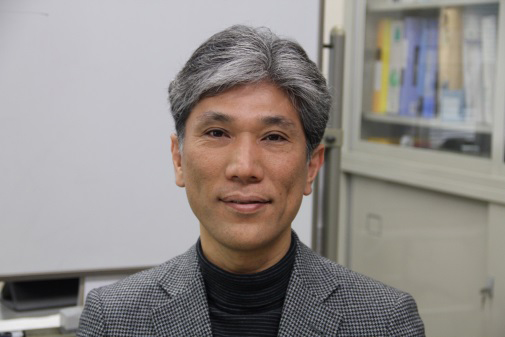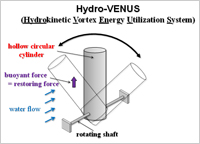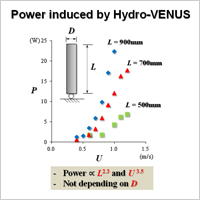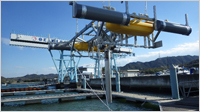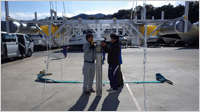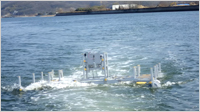Enlarge Image Fig.1: Hydrokinetic Vortex Energy Utilization System or Hydro-VENUS. The arrow which indicates vibration direction.
Enlarge Image Fig.2: Power induced by Hydro-VENUS in terms of the dimensions of the open cylinder.
Enlarge Image Fig.3: Offshore towing experiments
Enlarge Image Fig.3: Offshore towing experiments
Enlarge Image Fig.3: Offshore towing experiments
Enlarge Image
Pendulum power: Innovative pendulum-dynamo for converting tidal energy into electrical power
Okayama University's Shinji Hiejima is looking for industrial partners to commercialize his experimentally proven and patented concept of the Hydro-VENUS system for converting tidal energy into electrical power.
Research on converting tidal energy into electricity energy has a long history with the European Marine Energy Centre, in Scotland being one of the major international hubs for testing ideas on extracting energy from the motion of seas and tidal currents. In Japan the search for energy resources is a high priority with research on exploiting the power of the seas surrounding the Japanese archipelago being actively pursued. Notably, a report published by New Energy and Industrial Technology Development Organization (NEDO) in 2010 states that the potential of tidal energy in Japan is equivalent to 20 nuclear power plants. Furthermore, the Seto Inland Sea—where Okayama University is located—has been assessed as being a site with especially high potential.
"I want to exploit the mechanical motion of a pendulum to generate electricity from tidal currents," says Shinji Hiejima, an associate professor at the Graduate School of Environmental and Life Science of Okayama University. Hiejima was born in Iwakuni City, Yamaguchi Prefecture, famous for its Kintaikyo Bridge.
"My fascination with the structure of bridges triggered my research on the interaction of strong winds with massive bridges such as the Seto Bridge that connects Okayama with Kagawa in Shikoku," says Hiejima. "In my early research I analyzed why large bridges oscillate when hit by strong winds such as typhoons. Now, I am focusing on harnessing tidal energy as a stable source of electricity. I am looking for partners to develop my ideas on the Hydrokinetic Vortex Energy Utilization System or Hydro-VENUS—a large underwater pendulum based system."
Hiejima points out that propeller type turbine systems being tested in Europe has three major drawbacks: High strength required for the materials used for making the rotor blades leads to increases in cost; waste in the ocean clogs up and damages rotors; and, fisherman consider the sharp edges of rotor blades to be harmful to marine life.
To resolve these limitations of propeller based tidal energy conversion, Hiejima began by analyzing the potential of power generated by flow induced vibrations of cylinders placed horizontally in water. This approach overcomes aforementioned shortcomings of propeller but the vortex induced vibrations—the cylinder moves translationally as waves moves across them—in these systems typically only yields a power efficiency of approximately 37% of so-clled VIVACE converter obtained in the experiments of a group in the USA.
"The translational motion of cylinders (such as used in VIVACE) limits the efficiency of tidal flow induced vibrations of cylinders," says Hiejima. "My concept for the Hydro-VENUS shown in Fig.1 does not vibrate translationally but rotationally, and initial tests yielded a power efficiency of 76% as shown in Fig.2." Early tests were carried out using 1.5 m cylinders as shown in Fig. 3. Hiejima is now developing 20 m cylinders from a wide range of materials with the goal of producing highly efficient structures.
"I have patented and demonstrated the potential for my version of a pendulum-dynamo," says Hiejima. "I am looking for industrial partners to commercialize it."
Further information
Patent: Japanese patent: PCT/JP2012/004000 (Dynamo)
Website: http://www.cc.okayama-u.ac.jp/~hiejima/
Contact:[email protected]

